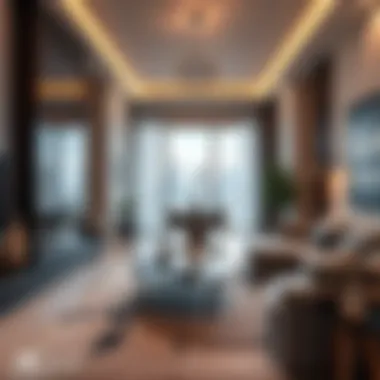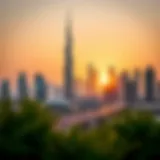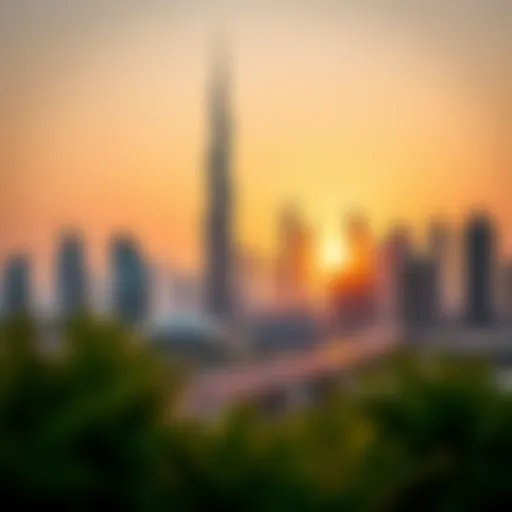Exploring Dubai's Vibrant Apartment Market


Intro
In recent years, Dubai has surged ahead as a notable hub for real estate, drawing attention from both local and international investors. The whimsical blend of modernity and tradition makes the city a beacon for various lifestyles, from lavish luxury to the more modestly priced options. Navigating this sprawling market requires a keen understanding of what's available and what drives trends therein.
This article aims to break down the complexities of Dubai's apartment market. We will explore key elements like current trends, the economic landscape that impacts property prices, and identify prime neighborhoods for investments. By diving deep into these topics, readers can arm themselves with knowledge to make informed choices, whether they're seasoned investors or new homebuyers keen to embrace life in this dynamic city.
Given the thriving nature of real estate here, it's essential to grasp how socio-economic factors influence market behaviors and pricing. The ultimate goal is to empower investors and lifestyle seekers alike, ensuring they understand the ropes of the Dubai apartment scene. Let's buckle up and delve into the market insights.
Preamble to the Apartment Market in Dubai
The apartment market in Dubai offers a unique tapestry woven from a blend of cultures, modern architecture, and a diverse demographic. As a global hub for business and tourism, Dubai continues to draw people from all walks of life, prompting a continuous need for housing solutions. Understanding the intricacies of this market is not merely academic; it holds practical implications for investors, homebuyers, and real estate agents alike.
With the backdrop of the city’s rapid development, delving into the apartment market can arm potential stakeholders with knowledge vital for making informed decisions. By examining recent trends, fluctuations in pricing, and emerging neighborhoods, this article aims to offer readers a clear roadmap through Dubai's complex real estate landscape.
Historical Context
The story of Dubai's apartment market is rooted in its dramatic transformation from a small fishing village to a powerhouse of innovation and luxury. In the late 20th century, economic development intensified, leading to a surge in real estate projects. The establishment of freehold property ownership laws in 2002 marked a turning point, empowering expatriates to invest in the property market. This shift opened the floodgates for foreign investment, creating a melting pot of residential projects tailored to various tastes and budgets.
Notable developments like the Burj Khalifa or the various luxury towers in Downtown Dubai stand as icons of this growth. The boom was met with a few speed bumps, notably the 2008 financial crisis that prompted a correction in property prices. However, the market has shown resilience, adjusting and evolving in response to economic shifts. The lessons from this history serve as groundwork for understanding today's dynamics.
Current Trends
Today, the apartment market in Dubai is characterized by several compelling trends. Firstly, there is a noticeable shift toward sustainable living, with developers increasingly incorporating green initiatives into new projects. Eco-friendly features, such as energy-efficient appliances and smart technologies, are no longer optional but expected by discerning buyers.
Furthermore, the impact of the COVID-19 pandemic has prompted a reevaluation of living spaces. Many now seek apartments that offer flexible layouts conducive to working from home, emphasizing the need for community-focused developments with shared amenities.
Comparative price analysis shows that while luxury apartments remain steadfastly valued, the affordability sector is gaining traction as local and regional economies recover from the pandemic's grip. Affordable housing initiatives are pivotal in addressing the needs of a growing population, making the apartment market more inclusive than ever before.
In summary, while the historical roots set the stage, the current trends highlight an evolving landscape that is responsive to technological advancements and societal needs. Investors and home seekers alike are now tasked with navigating this complex yet opportunistic environment.
"The Dubai apartment market is not just about finding a place to live; it’s about investing in a lifestyle and a future that is continually redefining itself."
Understanding these elements will shape perceptions and strategies in this ever-changing market.
Types of Apartments Available
Understanding the variety of apartments in Dubai is essential for anyone considering buying or investing in real estate here. This section delves into distinct types of apartments available in the city, each presenting unique benefits, considerations, and appeal to different demographic segments. Whether you are an investor looking to maximize returns, a homebuyer seeking your dream living space, or someone curious about the housing market, knowing the types of apartments can significantly shape your decisions in this vibrant metropolis.
Luxury Apartments
Luxury apartments in Dubai represent the peak of modern living. They are typically situated in prime locations such as Downtown Dubai or the Dubai Marina, boasting high-end amenities, opulent interiors, and breathtaking views of the cityscape or the Arabian Gulf. This segment of the market caters to affluent buyers and renters who prioritize comfort and exclusivity.
Some key features of luxury apartments include:
- Spacious layouts that often exceed the standards of typical living spaces.
- High-end fixtures and finishes such as marble flooring, designer kitchens, and smart home technology.
- Access to premium amenities, including swimming pools, fitness centers, spas, and concierge services.
Investing in luxury apartments can yield solid returns, especially in Dubai’s lucrative rental market, where foreign nationals often seek high-end accommodations. However, potential buyers should also be mindful of market saturation in some luxury segments, which may impact property values.
Affordable Housing Options
On the more budget-friendly side of the scale, affordable housing options are gaining traction as the demand for reasonably priced living spaces rises. With Dubai’s rapid population growth, a need for affordable flats has surged, prompting developers to create projects that cater to low to medium-income families.
Some characteristics of affordable housing include:
- Compact design with fewer square footage, while still offering practical and functional living environments.
- Located in up-and-coming neighborhoods, often with good transport links and community amenities.
- Competitive pricing and flexible payment plans that make home ownership accessible to a wider audience.
These properties often grant decent returns for investors and are a practical choice for first-time homebuyers or those looking for a more budget-friendly entry into the Dubai market. It's wise to further evaluate projects based on future development plans in surrounding areas to gauge potential appreciation values.
Serviced Apartments
Serviced apartments present a hybrid option that combines the convenience of hotel services with the comfort of home. Ideal for those seeking temporary accommodation or longer stays without the commitment of a traditional lease, this type of housing is especially popular among expatriates and business professionals.
Key traits associated with serviced apartments include:
- Fully furnished and equipped with household appliances, making move-in easy and hassle-free.
- Housekeeping services and general maintenance included, relieving residents of mundane chores.
- Short to medium-term lease options, appealing to transient populations who require flexibility.
The serviced apartment market has seen substantial growth, with many new developments emerging in central business districts and tourist hotspots. Investors may find potential in this niche, particularly given the rising tourism in Dubai and the influx of international professionals seeking temporary accommodations.


Overall, the types of apartments available in Dubai reflect its diverse population and ever-evolving real estate landscape. By understanding the nuances within this market, prospective investors and buyers can make informed choices that align with their individual needs and financial strategies.
Investment Potential in Dubai Apartments
Investing in Dubai's apartment market beckons those with an eye for opportunity. The amalgamation of a robust real estate sector and a surge in expatriate demand paints a promising picture for investors. Real estate in Dubai serves as a prime avenue, not just for affluent individuals, but also for mid-range investors keen on tapping into the city's fast-paced economy. With a constant influx of people from various corners of the globe, the demand for quality housing remains unwavering.
Return on Investment Analysis
When it comes to understanding the potential returns from Dubai's property market, a few crucial aspects come into play. Investors often analyze both the rental yields and capital appreciation.
- Rental Yields: Dubai typically offers attractive rental yields compared to many Western cities. As of recent studies, the city boasts average rental yields of 6-8%. Properties in prime locations like Dubai Marina and Downtown can yield even higher returns.
- Capital Appreciation: The unique market dynamics in Dubai also allow for considerable property value appreciation over time. Post-Expo 2020 developments have driven prices upward, with many areas seeing a rise between 15-20% year-on-year. Investors can leverage this growth to maximize their returns.
"Investing in Dubai’s apartment market is akin to finding a diamond in the rough – it demands insight and patience, but the rewards can be compelling."
However, it isn't just about numbers. Investors must consider market fluctuations. For example:
- Market Cycles: The Dubai property market experiences cycles of boom and bust, hence vigilance is essential. Investors should stay updated on economic indicators and consumer sentiment.
- Local Factors: Elements such as infrastructure developments, tourism influx, and government policies can significantly sway market performance. Keeping abreast of these factors ensures a savvy investment strategy.
Foreign Investment Regulations
Dubai has established a foreign-friendly environment which is a magnet for international investors. Understanding the regulations surrounding foreign investment in real estate is crucial for potential stakeholders.
- Freehold Ownership: Foreigners can buy freehold properties in designated areas like Dubai Marina and Palm Jumeirah. This ownership provides full control over the property, which is attractive to many.
- Visa Benefits: Investors are often enticed by the golden visa program. Purchasing property above a certain value allows investors and their families to avail of long-term residency.
- Regulatory Authorities: Entities such as the Dubai Land Department ensure transparency in transactions. These institutions safeguard both buyer's and seller's rights, making the market more appealing.
- Tax Environment: With zero property taxes and low transaction fees, Dubai stands out as a lucrative option for foreign investors seeking value.
In summation, the investment landscape of Dubai's apartment market is ripe with potential. With the right insights and awareness, investors can navigate this dynamic terrain effectively, ensuring fruitful returns on their investments.
Market Pricing Dynamics
Understanding market pricing dynamics offers a cornerstone for informed decision-making in Dubai's apartment market. It is important for investors, homebuyers, and real estate agents to grasp not just the numbers, but the underlying factors influencing those numbers. Prices do not exist in a vacuum; they are shaped by a medley of various elements challenging or enhancing an investor’s opportunity. This part of the article focuses on elaborating the specific elements, benefits, and considerations surrounding market pricing dynamics.
Factors Influencing Pricing
Prices in Dubai’s apartment market can swing like a pendulum based on several factors:
- Location: Prime locations like Downtown Dubai or Dubai Marina command higher prices due to their proximity to essential amenities and attractions.
- Supply and Demand: Like any market, a high demand for apartments coupled with limited supply can push prices upwards. Conversely, if many apartments flood the market without buyers, prices may take a hit.
- Economic Health: The wider economy plays a critical role; when the economy is robust and employment rates climb, people feel more secure purchasing homes, impacting demand positively.
- Government Policies: Initiatives from the Dubai government, be it new regulations or incentives for foreign investors, can shift the landscape by enhancing appeal or accessibility.
- External Influences: Factors like global economic conditions, foreign currency fluctuations, and geopolitical landscapes can ripple through the Dubai real estate market, altering buying power and investment decisions.
The interrelationship of these factors creates a complex web, weaving a narrative that determines market prices. The more one understands these elements, the better equipped they are to make sound decisions.
Comparative Market Analysis
Conducting a comparative market analysis (CMA) is vital for anyone looking to make a wise investment in Dubai’s apartment market. A CMA systematically studies the sale prices of comparable properties in a targeted neighborhood within a specified timeframe. Here’s why a CMA is integral:
- Determine Fair Market Value: By analyzing similar properties that have recently sold, stakeholders can assess whether a listing is over or underpriced, ensuring more accurate offers and negotiations.
- Market Trends Insight: A good CMA can provide a glimpse into trends—like identifying neighborhoods on the rise or potential declines, allowing buyers to time their purchases wisely.
- Negotiation Leverage: Having solid data from a CMA can empower buyers during negotiations, equipping them with details that back their offers.
- Investor Guidance: For those looking to buy apartments for rental purposes, a CMA highlights rental income potential based on similar units’ performance.
In essence, a solid CMA acts like a compass in the vast real estate landscape, facilitating smart choices and potentially high returns for investors.
"Understanding pricing dynamics is not just about numbers; it's about grasping the story those numbers tell in the context of Dubai's ever-evolving landscape."
For further insights and detailed statistics, consider exploring resources like Wikipedia's Market Trends and Investopedia's Guide to Comparative Market Analysis.
Neighborhoods to Watch
The neighborhoods within Dubai’s apartment market serve as a cornerstone for understanding the diversity and appeal this city has to offer. These areas do not just represent where buildings are; they embody investment potential, lifestyle choices, and cultural experiences. Recognizing which neighborhoods are poised for growth or are currently thriving helps investors and homebuyers navigate their options with a sharper lens.
Focusing on prominent districts allows one to assess factors such as rental yields, amenities, and demographic shifts. The right neighborhood can make all the difference, whether it’s for someone looking to invest in property or for those seeking a vibrant community to call home. Here, we explore three standout areas: Downtown Dubai, Dubai Marina, and Palm Jumeirah.
Downtown Dubai
Often dubbed the heart of the city, Downtown Dubai offers a tantalizing blend of modernity and tradition. One can’t swing a cat without hitting a major landmark. With the iconic Burj Khalifa soaring above, it attracts tourists and residents alike. This neighborhood is not just about impressive views; it also has a concrete comfort, with a variety of luxury apartments and high-end amenities.
Living in Downtown grants easy access to some of the city's best retail and dining experiences. The Dubai Mall, one of the largest shopping centers worldwide, sits just a stone's throw away, while the vibrant atmosphere of the Dubai Fountain performance adds charm to the local life.
However, buyers and investors must note the premium price tags associated with living here—the pros and cons must be weighed carefully. Prospective buyers should keep an eye on the balance between luxury and affordability, particularly if they want to cash in on future market trends.
Dubai Marina
Dubai Marina embodies the seaside living experience, replete with waterfront views and an array of leisure activities. This bustling neighborhood is a favorite among expatriates and locals alike, thanks in large part to a well-planned infrastructure that encompasses everything from high-rise apartments to lavish yachts moored along the marina.
The walkability factor here is significant, with the Dubai Marina Walk serving as a picturesque promenade lined with cafes and boutiques. However, there’s more than just aesthetics; it’s an investment magnet due to its consistent demand, making it a hotspot for rental yields.


One must consider the seasonality of the rental market here. During peak tourist seasons, prices can skyrocket, making it essential to remain attuned to market dynamics. Still, the blend of lifestyle amenities and community spirit makes it a desirable spot.
Palm Jumeirah
The Palm Jumeirah is an architectural marvel, often being referred to as the eighth wonder of the world. It offers luxury living at its finest, from private villas to upscale apartments. Homeowners here enjoy stunning sea views and direct access to pristine beaches.
This neighborhood caters to a high-end market, attracting affluent buyers worldwide. In addition, it boasts a unique lifestyle that includes a range of high-class hotels, beach clubs, and fine dining experiences, making it a fully-fledged paradise for those seeking exclusivity.
However, potential buyers must consider the higher barriers to entry due to elevated price points and service charges. As the Palm continues to develop, one can expect both property values and rental demand to flourish, making it a sound investment choice.
Regulatory Environment
Understanding the regulatory landscape surrounding the apartment market in Dubai is crucial for anyone looking to invest or reside in the vibrant city. The regulatory framework ensures that both landlords and tenants engage in fair practices, promoting a stable and transparent property market. This clarity fosters investor confidence, as it demystifies the intricacies of property ownership and tenant rights while ensuring a fine balance between interests of both parties. As such, being well-versed in these regulations is not just advisable, it's essential for navigating the Dubai apartment landscape.
Property Ownership Laws
Dubai’s property ownership laws are layered, reflecting the city’s diverse demographic and the rapid growth of its real estate market. With the introduction of freehold ownership opportunities in the early 2000s, non-UAE nationals gained access to own property in certain areas - a move that fundamentally restructured the landscape.
- Freehold vs. Leasehold: Freehold properties allow full ownership of the property and the land it sits on, while leasehold properties often come with ownership limited to a predefined period, typically 99 years. This distinction is significant, particularly for foreign investors who should scrutinize the type of ownership when considering an investment.
- Regulatory Bodies: The Dubai Land Department (DLD) plays a pivotal role. It registers property transactions, offers guidelines, and facilitates ownership transfers, ensuring practices are in line with local regulations. Investors and homeowners should familiarize themselves with the DLD and its services to utilize their offerings effectively.
- Recent Developments: Recent legal amendments have further streamlined the registration process, making it more accessible and efficient. For instance, online registrations through the DLD portal have significantly reduced the bureaucratic red tape, allowing buyers and sellers to conclude transactions more swiftly.
Those interested in investing should also be mindful of local laws regarding property taxes and additional fees that may come into play during purchasing, such as registration fees and maintenance costs, which can add up quickly.
Tenant Rights and Responsibilities
Navigating the responsibilities of tenants and their rights under Dubai’s Rental Law is equally important. These laws are designed not only to protect tenant interests but also to ensure landlords can maintain their properties effectively.
- Rental Contracts:
In Dubai, a clear and formal rental contract is mandatory, outlining the terms and duration of the lease. This should cover important aspects such as payment schedules, maintenance obligations, and conditions for termination. Both parties are encouraged to review these agreements closely. - Rent Cap Regulations: A tenant’s ability to challenge rental increases is also backed by law. The Rent Increase Committee, as established by the DLD, sets the cap for rent increments based on the Consumer Price Index. This ensures that tenants are not subject to inflated prices beyond reasonable levels.
- Eviction Procedures:
Evictions can be contentious. Landlords must follow specific protocols, notifying tenants in writing of impending evictions. Failure to adhere to these regulations can lead to legal disputes, making understanding tenant rights fundamental for both tenants and landlords.
Property regulations aim to create an environment of trust between landlords and tenants, ensuring that both parties fulfill their obligations within the legal framework.
These elements illustrate just how essential comprehending the regulatory landscape is for anyone looking to engage in Dubai's apartment market. Without a grasp on these regulations, investors and tenants alike risk falling into potential legal pitfalls, highlighting why this knowledge is not just beneficial but necessary.
Sustainable and Smart Living
The concept of sustainable and smart living has gained substantial traction in recent years, and in the context of Dubai’s apartment market, this theme is pivotal. As more people become aware of environmental issues, buyers and tenants alike show increased preference for apartments that integrate green initiatives and technology. This shift isn’t just a fad; it reflects a growing mindset towards responsible living, which is essential in a rapidly urbanizing locale like Dubai.
Eco-Friendly Developments
Eco-friendly developments are becoming more commonplace in Dubai’s apartment scene. These projects incorporate sustainable practices in their construction and functionality. For instance, buildings designed with energy-efficient materials not only reduce carbon footprints but also help minimize utility costs for residents.
Some examples seeing popularity include:
- Utilization of Solar Power: Many new apartment blocks are equipped with solar panels that harness the sun's energy, providing clean power for common areas and sometimes even residences.
- Rainwater Harvesting Systems: Implementing systems that collect and reuse rainwater not only conserves water but also addresses drainage issues, a practical concern in many urban areas.
- Green Roofs and Walls: These features promote biodiversity by allowing plants to grow on building surfaces. This can improve air quality and provide insulation, reducing energy needs.
"The shift towards eco-friendly apartments is no longer just a trend; it's becoming a necessary standard of living that reflects people’s values and aspirations."
When considering an apartment investment, it becomes crucial to look for these features. They not only align with global sustainability goals but also often stem from increasing legislation aimed at promoting environmental responsibility.
Smart Home Technologies
Smart home technologies are revolutionizing the living experience in Dubai. These innovations enhance comfort, security, and energy management, appealing particularly to tech-savvy individuals. Leveraging these technologies can be a significant deciding factor when purchasing or renting an apartment. They offer features like:
- Remote Control Systems: Homeowners can control lighting, temperature, and even doors from their smartphones or tablets. This level of convenience is increasingly sought after by prospective renters and buyers.
- Smart Energy Meters: These devices track energy consumption in real-time, allowing residents to make informed decisions about their usage patterns, potentially reducing wastage and lowering bills.
- Integrated Security Systems: With increased safety concerns, smart locks and video surveillance systems offer peace of mind while being easily accessible through mobile devices.
Implementing smart technologies not only enhances the day-to-day living experience but can also increase an apartment's market value. Homebuyers and investors are more inclined to pay a premium for properties featuring state-of-the-art technologies that promise convenience and efficiency.
As Dubai continues to develop, the embrace of sustainable and smart living will likely become a defining trait of its vibrant apartment market. Not only does this adapt to a growing demand, but it also sets a precedent for a future where environmental consciousness and technological integration go hand in hand.
Lifestyle Amenities in Apartment Living
In the bustling metropolis of Dubai, the allure of apartment living extends beyond mere accommodation. The lifestyle amenities associated with apartments play a crucial role in shaping the experiences and satisfaction of residents. As urban living continues to evolve, understanding what amenities are available and how they enhance daily life becomes indispensable, particularly for those looking to make informed real estate decisions.
Access to Retail and Dining
Living in a well-situated apartment can provide residents with immediate access to a vibrant array of retail and dining options. The chance to step outside and find a local café, grocery store, or boutique snuggled up in a vibrant inner city neighbourhood can significantly uplift the day-to-day life of residents.
- Convenience: Imagine waking up and having all your necessities right at your fingertips. This level of convenience lets residents enjoy spontaneous excursions to nearby shops or indulging in their favorite meals without trekking across town.
- Cultural Exposure: Dubai is a melting pot of cultures, and the dining options reflect this. Residents often find themselves surrounded by cuisines from every corner of the world, offering not just meals, but experiences that celebrate diverse traditions.
- Community Engagement: Retail spaces and restaurants also foster community engagement. Socializing in these spaces helps build bonds among neighbors - from chatting over coffee to participating in local events.
"The right amenities can elevate your living experience from just a place to sleep to a vibrant community hub."


Recreation and Leisure Options
Apartments increasingly cater to the modern lifestyle by incorporating recreational and leisure options that promote well-being and relaxation. The trending attributes of a home aren't just about square footage anymore; they delve deep into how the space interacts with its occupants' leisure time.
- Fitness Facilities: Many residential complexes include gyms, swimming pools, and wellness centers. These on-site facilities encourage an active lifestyle, often contributing to positive health outcomes for residents. Exercising within your building can save time and provide motivation, particularly when facilities are state-of-the-art.
- Green Spaces: Parks and open areas enhance outdoor experiences, offering ample opportunity for picnics, walking, or just enjoying serene views. An apartment with access to gardens or communal areas fosters a sense of peace and encourages social interactions with fellow residents.
- Entertainment Areas: The best apartment complexes often come equipped with lounges, movie theaters, or sports courts, ensuring that families and individuals have opportunities for pastime enjoyment and social gatherings without additional travel.
Ultimately, the fusion of retail, dining, and recreational facilities within apartment living directly influences potential residents' choices. As investments are made in these amenities, they not only add value to properties but also shape a holistic living experience worth pursuing.
Challenges in the Apartment Market
Navigating the apartment market in Dubai can feel like trying to find your way through a maze, riddled with twists and turns shaped by various challenges. As the market continues to evolve, understanding these hurdles becomes crucial for investors, homebuyers, and other stakeholders looking to make informed decisions. In this section, we will delve into significant challenges, particularly focusing on market fluctuations and over-supply issues, while discussing their implications on the landscape of apartment living in Dubai.
Market Fluctuations
Market fluctuations in Dubai's apartment sector can resemble the ebb and flow of the tide. Prices can swing dramatically based on broader economic conditions, government policies, and even global events such as oil price changes or pandemic impacts.
In recent years, for example, the pandemic induced uncertainty. Investment sentiments shifted sharply, causing residential prices to briefly tumble. According to the Dubai Land Department, the average apartment prices dropped by nearly 10% in 2020. However, as the economy starts to rebound, optimism has returned, resulting in price increases in prime areas.
- Key Considerations:
- Recognizing that property values may rise or fall can impact cash flow and reinvestment strategies for landlords.
- Buyers should research the timing of entry to the market, as purchasing during a downturn may offer lucrative long-term rewards.
Importantly, it's essential to keep an eye on macroeconomic indicators which can signal changes in the housing landscape. Keeping your ear to the ground can make all the difference.
Over-supply Issues
Over-supply issues in Dubai's apartment market have not gone unnoticed. With ambitious developments continually underway, there’s a risk of too many units flooding the market, challenging pricing strategies.
Historically, certain areas have seen a spike in available units, leading to greater competition among landlords. For instance, after the completion of megaprojects like Dubai Marina and Downtown Dubai, there came a time when oversupply created steep competition that drove rental prices down considerably.
- Signs of Over-supply:
- Increased vacancies in buildings, which can result in lost income for investors.
- More aggressive marketing tactics from developers, often leading to promotional offers such as rent discounts or free maintenance.
Although over-supply presents risks, it can also create opportunities for astute buyers and renters looking for deals. Investors armed with comprehensive market insights can capitalize on favorable conditions when they arise. If sellers are eager, buyers can negotiate better terms.
Future Outlook for the Apartment Sector
The apartment market in Dubai is more than just a place to lay your head; it's a vibrant ecosystem that reflects the city's dynamic growth and development. Understanding the future outlook of this sector is crucial for several reasons. For investors and residents alike, recognizing upcoming trends and potential growth areas can lead to insightful decisions that align with personal or financial goals. As Dubai continues its trajectory as a global city, the apartment sector is poised for substantial change. In this section, we will delve into emerging trends and predictions for market growth that will shape the future of Dubai’s apartment living.
Emerging Trends
Dubai’s apartment market is witnessing some intriguing currents that signal new beginnings in style, functionality, and sustainability. Here are some of the key emerging trends to watch:
- Sustainability: More developers are diving into eco-friendly construction methods. Projects are increasingly emphasizing energy efficiency. This shift is not just a trend; it is becoming a necessity, as environmental regulations tighten and consumer preferences evolve.
- Smart Technology: With the rise of IoT, smart home features are becoming standard in many apartments. From advanced security systems to automated climate control, technology is enhancing everyday living. Buyers often expect these features as a matter of course, rather than an upgrade.
- Mixed-use Developments: The increasing popularity of mixed-use developments signifies a shift towards community-centric living spaces. These properties blend residential, retail, and recreational spaces into cohesive environments, enhancing convenience and accessibility.
"Investing in apartments that prioritize sustainability and technology will likely yield better returns in the long run."
Predictions for Market Growth
Looking ahead, several predictions can be made regarding the growth of Dubai's apartment market. These insights draw on current data, market dynamics, and consumer behavior:
- Continued Demand: The demand for apartments in Dubai is expected to stay strong, driven largely by the city’s reputation as a hub for business, tourism, and culture. Despite fluctuations, the influx of expatriates and international investors continues to buoy market performance.
- Price Stabilization: After a period of fluctuations, prices are likely to stabilize. This stabilization may result from a balance between supply and demand. The ongoing completion of new projects, coupled with a shifting focus toward quality over quantity, is expected to help achieve this balance.
- Focus on Affordable Housing: With the government’s encouragement of affordable housing initiatives, we may see an uptick in developments targeting middle-income buyers. This broader focus on affordability could also lead to a more diverse demographic within the apartment sector.
In summary, understanding the future outlook for the apartment market in Dubai provides essential guidance for all stakeholders. As technological innovations, sustainability efforts, and demographic shifts define this landscape, being informed will enable more strategic decisions moving forward.
End and Key Takeaways
In concluding our exploration of Dubai's apartment market, it becomes paramount to encapsulate the insights gleaned throughout this article. The rapid evolution of this market makes it not just an economic focus but a lifestyle choice for many, especially with the ongoing development projects and governmental initiatives fostering growth.
Summary of Insights
Dubai’s apartment landscape is a kaleidoscope of options ranging from luxurious high-rises to more affordable units catering to various demographics. It offers something for everyone – whether you are a discerning investor eyeing premium returns or a young professional searching for a modern living space.
- Historical Growth: The apartment sector has matured significantly. The historical context reveals a market driven by expatriate demand and steady population growth, solidifying Dubai's stature as a global real estate hub.
- Pricing Dynamics: One of the defining characteristics of Dubai's market is its pricing structure influenced by various factors like location, amenities, and the developer’s reputation. Recent trends show a movement towards more competitive pricing, making ownership more attainable.
- Neighborhood Insights: Certain neighborhoods such as Downtown Dubai and Palm Jumeirah showcase high potential for investment due to their ongoing enhancements and attractiveness. In contrast, emerging areas may offer unexpected value for those willing to delve beyond the obvious.
This snapshot serves not just as a summary but as a guideline for potential investors and homebuyers alike.
Final Recommendations
For those considering investing in Dubai’s apartment market, some key takeaways should shape your decision-making process:
- Comprehensive Research: Investigate different areas thoroughly. The right neighborhood can make all the difference in your investment's potential.
- Understand Market Trends: Stay updated with market fluctuations. Knowledge about upcoming projects can provide insights into where values might rise.
- Consider Long-term Viability: Look at properties not merely as financial investments but also as spaces for future living. Evaluate your lifestyle needs alongside investment potential.
- Leverage Professional Guidance: Working with local real estate experts can streamline the process and help in navigating legalities. Their understanding of regulations—including foreign investment rules—will be crucial.
- Factor in Amenities and Lifestyle: Properties offering desirable lifestyle amenities can be more attractive, both for tenants and resale value.
Ultimately, Dubai presents a vibrant and evolving market for apartment living. Approaching it with due diligence and an informed mindset can lead to fruitful opportunities, whether it's to call home or as an investment venture.







